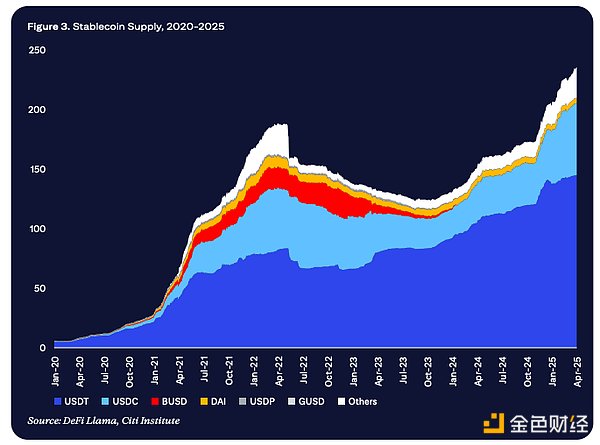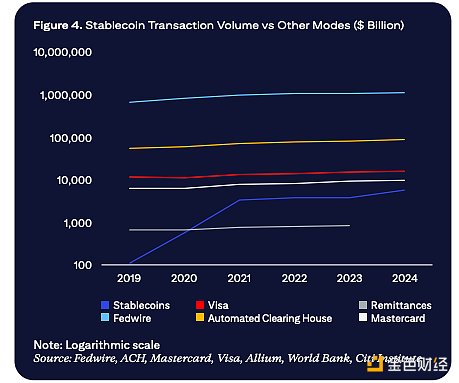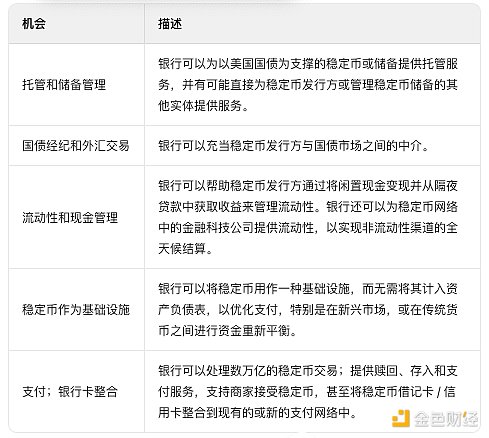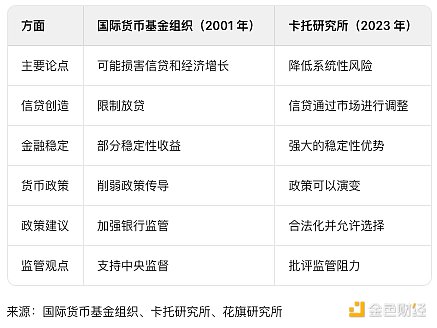Written by: AIMan@Golden Finance
On April 25, 2025, Citi Institute, a subsidiary of Citibank, released a research report on "Digital Dollar". The key points of the research report are:
1. 2025 is expected to be the "ChatGPT moment" for the application of blockchain in the financial and public sectors, a trend driven by regulatory changes.
2. Citi predicts that the total circulation supply of stablecoins in 2030 may grow to US$1.6 trillion in the base case; US$3.7 trillion in the optimistic case, and around US$500 billion in the pessimistic case.
3. It is expected that the supply of stablecoins will still be mainly denominated in US dollars (about 90%), while non-US countries will promote the development of their own CBDCs.
4. The US regulatory framework for stablecoins may drive new net demand for US Treasuries, and by 2030, stablecoin issuers may become one of the largest holders of US Treasuries.
5. Stablecoins pose a certain threat to the traditional banking ecosystem by replacing deposits. But they may also provide opportunities for banks and financial institutions to provide new services.
As the title of its report "Digital Dollar" implies, Citi is highly optimistic about stablecoins, and the report has a special chapter explaining that "the ChatGPT moment of stablecoins is coming." Golden Finance AIMan specially compiled Stablecoins: A ChatGPT Moment?" section, as follows:
How do stablecoins work?
A stablecoin is a cryptocurrency that aims to maintain a stable value by pegging its market price to a reference asset. These reference assets can be fiat currencies such as the U.S. dollar, commodities such as gold, or a basket of financial instruments. The key components of a stablecoin system include:
Stablecoin issuer:The entity that issues the stablecoin is responsible for maintaining its price peg by holding an underlying asset equal to the circulating supply of the stablecoin.
Blockchain ledger:After the stablecoin is issued, the transaction is recorded on the blockchain ledger. The ledger provides transparency and security by tracking the ownership and flow of stablecoins between users.
p>Reserves & Collateral:Reserves ensure that each token can be redeemed at the pegged value. For fiat-collateralized stablecoins, these reserves typically include cash, short-term government securities, and other liquid assets.
Digital Wallet Providers:Provide digital wallets, which can be mobile apps, hardware devices, or software interfaces, that allow stablecoin owners to store, send, and receive their tokens.
How do stablecoins maintain their pegged value?
Stablecoins rely on different mechanisms to ensure that their value is consistent with the underlying asset. Fiat-backed stablecoins maintain their peg by guaranteeing that each token issued can be redeemed for an equal amount of fiat currency.
Major Stablecoins

Figure 3 Stablecoin supply from 2020 to 2025
The transaction volume of stablecoins has grown rapidly in recent years. After adjustment, 112, 192);">Monthly trading volume of stablecoins in Q1 2025 is between $650 billion and $700 billion
, about twice the level in the second half of 2021 to the first half of 2024. Supporting the crypto ecosystem is the main application scenario of stablecoins.
The largest stablecoin, USDT, was launched on the Bitcoin blockchain in 2014 and expanded to the Ethereum blockchain in 2017, enabling its use in DeFi. In 2019, it further expanded to the TRON network, which is widely used in Asia, due to its faster speed and lower cost. USDT has largely operated offshore, but times are changing.

Figure 4 Stablecoin transaction volume compared to other payment methods (in billions of US dollars)
We will definitely see more players (especially banks and traditional institutions) enter the market. US dollar-backed stablecoins will continue to dominate. Ultimately, the number of players will depend on the number of different products required to cover the main application scenarios, and there will probably be more players in this market than in the bank card network market. - Matt Blumenfeld, Global and US Head of Digital Assets, KPMG
What are the drivers of stablecoin adoption in the United States and around the world?
Erin McCune, Founder, Forte FinTech:
Practical advantages (speed, low cost, 24/7 availability): Demand is created in both developed economies (especially those where instant payments are not widely available, SMEs are underserved by existing institutions, and multinational companies want to make global money transfers more convenient) and emerging economies (regions where cross-border transaction costs are high, banking technology is immature, and/or financial inclusion lags).
Macro demand (hedging inflation, financial inclusion): In some regions, stablecoins have become a "lifeline" for people. In countries such as Argentina, Turkey, Nigeria, Kenya, and Venezuela, where currencies are volatile, consumers use stablecoins to protect their funds. Today, more and more remittances are made in the form of stablecoins, and consumers without bank accounts can also use digital dollars.
Support and integration of existing banks and payment providers: This is key to legitimizing stablecoins (especially for institutional and corporate users) and can quickly expand their scope and utility. Mature, large-scale payment networks and core processors can bring transparency and promote integration with familiar solutions that businesses and merchants rely on. Enabling clearing mechanisms between different stablecoins and between banks and non-banks is also critical to scaling. Technological improvements for consumers (easy-to-use wallets) and merchants (integrating stablecoin collection capabilities into acquiring platforms via APIs) are removing barriers that once limited stablecoins to the fringe of crypto.
Long-awaited regulatory clarity: This enables banks and the broader financial services industry to adopt stablecoins in both retail and wholesale operations. Transparency (audit requirements) and consistent liquidity management (reliable parity) will also simplify operational integration.
Matt Blumenfeld, Global and US Head of Digital Assets at KPMG:
User Experience: The global payments landscape is increasingly shifting to real-time digital transactions. But the challenge for every new payment method in its rollout is the customer experience - is it intuitive, can you see the use case, is the value clear. Any institution that successfully improves the customer experience, whether it is for retail or institutional users, will stand out in their respective fields. Integration with current payment methods will drive the next wave of payment method adoption. On the retail side, this is reflected in the combination with bank card payments or penetration in the mobile wallet field; on the institutional side, it is reflected in simpler, more flexible and cost-effective settlement methods.
Regulatory clarity: With the introduction of new stablecoin regulations, we can see the extent to which regulatory uncertainty has previously inhibited innovation and promotion around the world. The introduction of the EU Crypto-Asset Market Regulation (MiCA), regulatory clarity in Hong Kong, and the advancement of stablecoin legislation in the United States have all triggered a wave of activities focused on simplifying the flow of funds for institutions and consumers.
Innovation and efficiency: Institutions must view stablecoins as an enabler for more flexible product development, which is not easy at present. This means providing a more convenient, creative and attractive medium that enhances the functions of traditional bank deposits, such as generating income, programmability and composability.
Potential market size of stablecoins
As Erin McCune, founder of Forte Fintech, pointed out, any prediction of the potential market size of stablecoins needs to be treated with a certain degree of caution. There are many variables, and our scenario analysis shows a wide range of forecasts.
We construct a forecast range based on the following factors that drive the demand for stablecoins:
A portion of the US dollar is shifted from paper money to stablecoins both overseas and domestically: US dollar paper money held overseas is often a safe haven against local market volatility, and stablecoins are a more convenient way to access this hedge. Domestically, stablecoins are used to some extent for certain payment functions and are held for this purpose.
Households and businesses in the United States and internationally reallocate some of their short-term US dollar liquidity to stablecoins: This is because stablecoins are convenient to use (e.g., they can be traded across borders around the clock), which helps with cash management and payment operations. Stablecoins may also partially replace yield-generating assets if regulations allow.
In addition, we assume that US households and businesses will also see a similar reallocation trend in short-term EUR/GBP liquidity as short-term US dollar liquidity, although on a much smaller scale. Our overall base and bullish case forecasts for 2030 assume that the stablecoin market remains dominated by the U.S. dollar (~90% share).
Growth of the public cryptocurrency market:Stablecoins are used as settlement instruments or on-ramp to deposits and withdrawals. This is driven in part by institutional adoption of public crypto assets and the general application of blockchain technology. In our base case, the trend of stablecoin issuance growth in 2021-2024 is assumed to continue.
Citi Research estimates the stablecoin market size in 2030 to be $1.6 trillion in the base case, $3.7 trillion in the bullish case, and $0.5 trillion in the bearish case.

Figure 5 Forecast of the stablecoin market size in 2030

Figure 6 Stablecoin Market Size in 2030
Note: The stock of total money supply (cash in circulation, M0, M1 and M2) in 2030 is calculated based on nominal GDP growth. The Eurozone and the UK may issue and adopt local stablecoins. China may adopt sovereign central bank digital currencies and is unlikely to adopt foreign privately issued stablecoins. The estimated size of non-US dollar stablecoins in 2030 is $21 billion, $103 billion and $298 billion in bear, base and bull scenarios, respectively.
Stablecoin Market Outlook
Erin McCune, Founder of Forte Fintech
Q: What do you think of the optimistic and cautious outlook for the size of the stablecoin market in the near term, and the potential factors driving its development trajectory?
It takes a lot of confidence (or overconfidence) to predict the growth of the global stablecoin market, as there are still many unknown factors. As a reminder, here are my scenarios for both the bull and bear cases:
The most optimistic forecast sees the market expanding 5-10x as stablecoins become an everyday medium for instant, low-cost, low-friction transactions around the world. In the bull case scenario, stablecoins will grow exponentially in value from ~$200 billion today to $1.5-2.0 trillion by 2030, penetrating global trade payments, person-to-person remittances, and mainstream banking. This optimistic outlook is based on several key assumptions:
Favorable regulation in key regions: not only Europe and North America, but also markets such as Sub-Saharan Africa and Latin America where demand for alternative local fiat currencies is greatest.
True trust between incumbent banks and new entrants: and widespread consumer and corporate confidence in the integrity of stablecoin reserves (e.g., $1 stablecoin = $1 equivalent fiat currency).
Intentional distribution of income (and savings) along the value chain: to foster collaboration.
Wide adoption of technologies that can bridge new and legacy infrastructure: to foster structural efficiency and scale. For example, merchant acquirers have already started using stablecoins. For wholesale payment applications, corporate treasury and accounts payable solutions and treasurers will need to adapt. Commercial banks will also need to deploy tokenization and smart contracts.
In the bear scenario, stablecoin usage will be limited to the crypto ecosystem and specific cross-border use cases (mainly markets with illiquid currencies, which currently account for a small proportion of global GDP). Geopolitical factors, resistance to digital dollarization, and widespread adoption of central bank digital currencies will further hinder the growth of stablecoins. In this scenario, the market capitalization of stablecoins may stagnate at $300-500 billion, with limited relevance in the mainstream economy. The following factors will lead to a more pessimistic scenario:
If one or more major stablecoins experience a reserve failure or depegging event: This will significantly erode the trust of retail investors and businesses.
Friction and cost when using stablecoins for everyday purchases: For example, remittance recipients cannot use them to buy groceries, pay tuition and rent, and businesses cannot easily use funds for wages, inventory, etc.
Retail central bank digital currencies have yet to gain traction: but in regions where digital cash alternatives offered by the public sector have achieved scale, the relevance of stablecoins may decrease.
In regions where stablecoins grow and further weaken the relevance of local fiat currencies: central banks may respond by tightening regulation.
If fully reserve-backed stablecoins grow too large: this could “lock up” a large amount of safe assets as backing, potentially restricting credit in the economy.
Q: What are the current and future use cases for stablecoins?
Like any other form of payment, the relevance and potential growth of stablecoins must be considered based on the specific use case. Some use cases have already gained traction, while others remain theoretical or are clearly impractical. Here are the current (or near-term) use cases for stablecoins that make sense, ranked from largest to smallest contribution to the total eventual market (TAM) of stablecoins:
Cryptocurrency trading: Currently, the use of stablecoins by individuals and institutions to trade digital assets is the largest use case for stablecoins, accounting for 90-95% of stablecoin trading volume. Much of this activity is driven by algorithmic trading and arbitrage. Given the continued growth of the cryptocurrency market and its reliance on stablecoin liquidity, transactions (retail + decentralized finance activity) are likely to still account for around 50% of stablecoin usage by value at maturity.
Business-to-business payments (corporate payments): According to the Society for Worldwide Interbank Financial Telecommunication (Swift), the vast majority of transaction value in traditional correspondent banking reaches its destination within minutes via the Swift global payments innovation platform. But this occurs primarily between money center banks, using liquid currencies and during banking hours. There are still many inefficiencies and unpredictability when doing business, especially with low- and middle-income countries. Corporates using stablecoins to pay overseas suppliers and manage treasury operations could account for a significant share of the stablecoin market. Global business-to-business flows are in the trillions of dollars, and even if only a small portion shifts to stablecoins, it could account for around 20-25% of the total eventual stablecoin market in the long run.
Consumer Remittances: Despite a steady shift away from cash and toward digital payments, regulatory pressure, and efforts by new entrants, it remains expensive for workers abroad to send money to friends and family back home (5% on an average $200 transaction, five times the G20 target). With lower fees and faster speeds, stablecoins are poised to capture a significant share of the ~$1 trillion remittance market. If the promised instantaneity and significant cost reductions are achieved, this could account for 10-20% of the market in a high adoption scenario.
Institutional Trading and Capital Markets: Stablecoins are being used by professional investors or to settle tokenized securities transactions for a growing number of use cases. Large-scale flows (forex, securities settlement) may begin to use stablecoins to speed up settlement. Stablecoins could also simplify the funding process for retail stock and bond purchases, which is currently typically done through batch automated clearing house processing. Large asset managers are already piloting stablecoins for settlement, laying the foundation for widespread use in capital markets. Given the large volume of payments flowing between financial institutions, this use case could account for around 10-15% of the stablecoin market, even if adoption is low.
Interbank liquidity and treasury management: The use of stablecoins by banks and financial institutions for internal or interbank settlements is relatively small (perhaps less than 10% of the total market), but has a large potential impact. Industry leaders have already launched blockchain projects with daily transaction volumes exceeding $1 billion, which shows its potential, although regulation remains unclear. This area is likely to grow significantly, although there may be some overlap with the institutional use cases mentioned above.
Stablecoins: Bank Cards, Central Bank Digital Currency and Strategic Autonomy
We believe that the use of stablecoins is likely to grow, and these new opportunities will create space for new entrants. The current issuance duopoly is likely to continue in the offshore market, but new players may join the onshore market in each country. Just like the bank card market has evolved over the past 10-15 years, the stablecoin market will also change.
Stablecoins have some similarities to the bank card industry or cross-border banking. All of these areas have high network or platform effects, and strong reinforcing loops. More merchants accepting a trusted brand (Visa, Mastercard, etc.) attracts more cardholders to choose that card. Stablecoins have a similar adoption cycle.
Stablecoins have typically been outside of financial regulation in larger jurisdictions, but this is currently changing in the EU (Markets in Crypto-Assets Regulation 2024) and the US (where regulation is moving forward). The need for tighter financial regulation, coupled with the high costs of partnering, could lead to a concentration of stablecoin issuers, as we have seen with card networks.
Fundamentally, having a small number of stablecoin issuers is good for the broader ecosystem. While one or two major players may seem concentrated, too many stablecoins can lead to fragmented, non-interchangeable forms of money. Stablecoins thrive when they have scale and liquidity. Raj Dhamodharan, Executive Vice President of Blockchain and Digital Assets, Mastercard
However, evolving political and technological developments are making the card market increasingly heterogeneous, especially outside the US. Will the same happen in the stablecoin space? Many countries have developed their own national bankcard schemes, such as Brazil’s Elo card (launched in 2011), India’s RuPay card (launched in 2012), and others.
Many of these national bankcard schemes were launched out of national sovereignty concerns and were driven by local regulatory changes and political encouragement for domestic financial institutions. They also facilitated integration with new national real-time payment systems, such as Brazil’s Pix system and India’s Unified Payments Interface (UPI).
In recent years, while international bankcard schemes have continued to grow, their share has declined in many non-U.S. markets. In many markets, technological change has led to the rise of digital wallets, account-to-account payments, and super apps, all of which have eroded their market share.
Just as we have seen the proliferation of national schemes in the bankcard market, we are likely to see jurisdictions outside the U.S. continue to focus on developing their own central bank digital currencies (CBDCs) as a tool of national strategic autonomy, particularly in the wholesale and corporate payments space.
A survey of 34 central banks by the Official Monetary and Financial Institutions Forum (OMFIF) showed that 75% of central banks still plan to issue central bank digital currencies. The proportion of respondents who expect to issue central bank digital currencies in the next three to five years has increased to 34% in 2024, from 26% in 2023. At the same time, some practical implementation issues have become increasingly apparent, with 31% of central banks delaying issuance due to legislative issues and the desire to explore broader solutions.
CBDCs began in 2014, when the People's Bank of China began research on the digital yuan. Coincidentally, this is also the year Tether was born. In recent years, stablecoins have developed rapidly, driven by private market forces.
By contrast, central bank digital currencies are still largely in the official pilot project stage. The few smaller economies that have launched national central bank digital currency projects have not seen a large number of users spontaneously using them. However, the recent increase in geopolitical tensions may attract more attention to central bank digital currency projects.
Stablecoins and Banks: Opportunities and Risks
The adoption of stablecoins and digital assets offers some banks and financial institutions new business opportunities to drive revenue growth.
The Role of Banks in the Stablecoin Ecosystem
Matt Blumenfeld, Global and US Digital Asset Leader, PwC
There are many opportunities for banks to participate in the stablecoin space. This can be directly as a stablecoin issuer, or a more indirect role as part of a payment solution, building structured products around stablecoins, or providing general liquidity support. Banks will find ways to continue to be a medium of exchange for the flow of funds.
As users pursue more attractive products and better experiences, we are seeing deposits flow out of the banking system. With stablecoin technology, banks have the opportunity to create better products and experiences while keeping deposits within the banking system (where users generally prefer to have their deposits protected), just through new channels.

Figure 7: Banks and Stablecoins: Revenue and Business Opportunities
At the system level, stablecoins may have similar effects to "narrow banks", and the pros and cons of such institutions have long been debated at the policy level. The shift of bank deposits to stablecoins may affect banks' lending capacity. This reduction in lending capacity may at least suppress economic growth during the transition period of system adjustment.
Traditional economic policy opposes narrow banks, as summarized in the IMF's 2001 report, based on concerns about credit creation and economic growth. The Cato Institute put forward an opposite view in 2023, with similar voices arguing that "narrow banking" can reduce systemic risk, and credit and other capital flows will adjust accordingly.

Figure 8: Different views on narrow banking
 Brian
Brian









